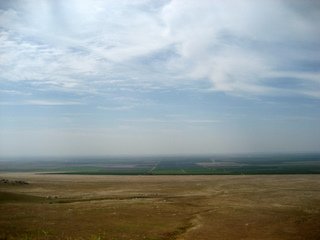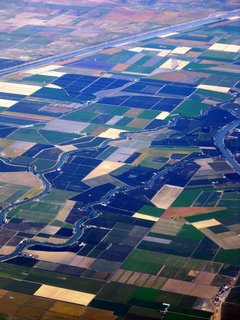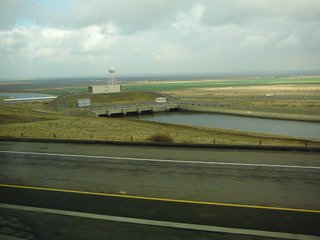Discovering Northern California
California's Great Central Valley
The Central Valley:
All That is Gold Does Not Glitter
Poem by J. R. R. Tolkien
California's Central Valley turned out to be a gold mine of a different sort! While the California Gold Rush was the catalyst that spurred the scramble to reach and eventually settle California, that precious metal was not the only gold to be found here!
Drive the almost 500 miles along Highway 99 or Interstate 5, from Redding in the North to Bakersfield in the South, and you'll see what we mean.
The Great Central Valley, tucked away and hidden between the Sierra Nevada Mountains and the Coastal Range, was the state's ultimate gold mine!
And the gold came from the ground, but not as you would expect. This gold took the form of agricultural crops and products.
In fact, Mark Bittman in a New York Times article called the Valley "our greatest food resource." That's because it produces "more than 230 crops", providing "a third of all the produce grown in the United States."
California Agriculture Turned Out to be
the Ultimate Gold Mine!
 The Valley is long and flat
The Valley is long and flatCC Chazz Layne
The Central Valley is a long, wide stretch of flatland barely above sea level.
It was originally comprised of Oak woodlands, bunch-grass prairies, and huge tule marshes.
Some of the first Europeans drawn to it were trappers interested in the abundance of beaver in the valley in the 1820s.
But when the throngs of prospectors from all over the world began the stampede to the Gold Fields of California, some folks realized that all those miners would need to be fed.
But when the throngs of prospectors from all over the world began the stampede to the Gold Fields of California, some folks realized that all those miners would need to be fed.
So they began to eye The Valley for it's rich, fertile soil and long summer growing season.
And it paid off handsomely.
Soon they were draining swamps and rivers, building levees and dams, and introducing exotic plant species to open up the area to farming and grazing.
Today, The Valley is the richest agricultural region in the world, producing a goodly portion of the world's cotton, grains like oats and rice, beans, fruit and nut crops, and vegetables and melons, for a total of $37.5 billion in cash farm receipts revenue for 2010.
The Great Central Valley is actually comprised of two valleys - the Sacramento, which receives about 20 inches of rain per year; and the San Joaquin (pronounce san-wah-KEEN), which is much drier and even semi-arid in places.
The incredible range and scope of agricultural products make up the largest portion of the economies throughout both of these valleys - and for me, watching our food grow in the fields and orchards of the farmland that surrounds us is a real treat! When the kidlettes were young, we were always stopping to see how cotton bolls formed on the plant, or what almonds looked like on the tree.
But popular California attractions reside in The Valley as well! Believe me when I say, there's plenty to keep the sightseer in us entertained - from outdoor activities, to history, to museums and opera!
So they began to eye The Valley for it's rich, fertile soil and long summer growing season.
And it paid off handsomely.
Soon they were draining swamps and rivers, building levees and dams, and introducing exotic plant species to open up the area to farming and grazing.
Today, The Valley is the richest agricultural region in the world, producing a goodly portion of the world's cotton, grains like oats and rice, beans, fruit and nut crops, and vegetables and melons, for a total of $37.5 billion in cash farm receipts revenue for 2010.
The Great Central Valley is actually comprised of two valleys - the Sacramento, which receives about 20 inches of rain per year; and the San Joaquin (pronounce san-wah-KEEN), which is much drier and even semi-arid in places.
The incredible range and scope of agricultural products make up the largest portion of the economies throughout both of these valleys - and for me, watching our food grow in the fields and orchards of the farmland that surrounds us is a real treat! When the kidlettes were young, we were always stopping to see how cotton bolls formed on the plant, or what almonds looked like on the tree.
But popular California attractions reside in The Valley as well!
Believe me when I say, there's plenty to keep the sightseer in us
entertained - from outdoor activities, to history, to museums and opera!
The Upper Valley
The Sacramento Valley makes up the Northern portion of The Valley, and runs from Redding in the North to the Stockton Delta area, just South of Sacramento.
Major towns and cities along the central corridor of the valley include:
- Redding: Shasta County; home of the Sundial Bridge and Lake Shasta;
- Red Bluff and Corning: Tehama County; William B. Ide SHP, "Olive City";
- Chico and Oroville: Butte County; Bidwell Mansion, Bidwell Park, Table Mountain, and Lake Oroville;
- The Twin Cities of Yuba City: Sutter County; "Prune Capital of the World," and Marysville: Yuba County; "Gateway to the Goldfields";
- Sacramento: Sacramento County; California's State Capital; Lodi and Stockton: San Joaquin County; Delta Country and "Asparagus Capital of the World".
Agricultural products throughout the Sacramento Valley include citrus, fruit, and nut orchards, rice, feed crops, cattle ranches, olives and olive oils, California wine grapes, and even dairies.
As for California attractions, explore the vast array of historical sites, dip your toes, your boats, and your fishing lines in the many waterways, visit the cities and towns, attend the events and festivals, and - most obviously, if you think about it - explore the Farm Trails and stop at the fruit and veggie stands!
The Sacramento Valley also houses the only natural vertically-configured land mass throughout The Valley - Sutter Buttes, an anomaly that's often referred to as the World's Smallest Mountain Range.
The Lower Central Valley
By far the larger portion of The Valley belongs to the San Joaquin Valley, which stretches from The Delta in the North to Bakersfield and the Tehachapi Mountains in the South, and is approximately 50 miles wide.
This is the land that John Steinbeck's Dust Bowl family fell in live with in The Grapes of Wrath - because perhaps, after all the mountain crossings along their journey, they'd finally round a place that was flat enough and big enough to remind them of the homes they'd been forced to leave behind.
From Lodi and Stockton South, the major cities and towns of the San Joaquin Valley include:
- Modesto: Stanislaus County; former home to George Lucas and an American Graffiti classic;
- Atwater, Merced, and Los Banos: Merced County; Castle Air Force Base, the "Gateway to Yosemite," and "The Baths";
- Fresno: Fresno County; the heart of California Dancing Raisins' country and back door to Yosemite;
- And Bakersfield: Kern County; "California's Country Music Capital".
The San Joaquin Valley is a major agricultural player only because of its extensive system of reservoirs, aqueducts, and irrigation canals. But it's often referred to as the "Food Basket of the World" because of the dollar value and the diversity of the crops it provides, including grapes (table, raisin, and wine), cotton, nuts, citrus, vegetables and fruits, feed crops, cattle ranches, and dairies.
As for recreation and entertainment, all those waterways are not only for watering crops! You'll find ample opportunities for water sports, camping, fishing, and hunting (especially for waterfowl). Visit wineries; tour the State Capitol Building; explore museums, zoos, historic sites; and golf in the California sunshine!
We'll have more to share with you about the Great Central Valley in the coming weeks; things like:
- California Central Valley Attractions
From North to South and East to West! - California Central Valley Beaches
Along the rivers, lakes, and reservoirs! - California Central Valley Communities
From farm towns to cities! - California Central Valley Parks and Preserves
State Parks, Nature Preserves, Marshes and Bogs!
Please continue your exploration of what Northern California has to offer by using the Nav Bars in the left and right columns or by using the links at the bottom of the page.
Like what you're finding here at Discovering Northern California? Then please share with the Social Network of your choice.
And thanks for coming!
Return to Discover Northern California's Home Page from
California Central Valley
- Home Page
- CA Central Valley
Related Articles
California's Central Valley
Related Articles
Shasta Cascade
Butte County
Modoc County
Shasta County
Siskiyou County
Tehama County
Trinity County
Related Pages
California Gold Rush
California Gold Rush
Discovery of Gold
Getting to California
Gold Rush Trail
Gold Rush Sites
Gold Panning
Related Pages
Things To Do
Activity Village
Attractions
Beaches
Beer Lovers Delight
Burney Falls
Camping
Casa de Fruta
Day Trips
Gold Panning
Gold Rush Sites
Healdsburg
Historic Grass Valley
Lake Shasta Caverns
Lodi
Missions
Nevada City
RV Destinations
Ski Resorts
Tide Pool Tips
Travel Tips
Weekend Trips
Whale Watching
Wine Tasting
Related Pages
Insider Secrets
Best Kept Travel Secrets
Best Winter Whitewater
Boring Road? Nope
CA Admission Day
Climbing at Castle Rock
Crabbing Spots
Dream of Dreams
Fall in Eastern Sierras
Ghost Stories
Glass Beach
Great Stays, Low Pays
How to be a Valley Girl
Jade Beach
Lake Shasta Caverns
Lassen Volcanic SP
Lost Coast
Mono Lake
Moss Landing: Whales
New Clairvaux Abbey
Panning for Gold
Pygmy Forest
Mendo to Eureka
RV Destinations
SF Great Places to Eat
SF: More About Eating
SF Neighborhoods
SF Giants Baseball
Santa Cruz: Memories
Santa Cruz: Old Friends
Sonoma Cooking Class
Sonoma History
Sonoma Top Wine Stop
Tahoe: Discovery Trail
Underground Gardens
Yosemite: Family Hikes
Yosemite: High Country
YNP: Off the Beaten Path
Yosemite: Taft Point
Ziplines

